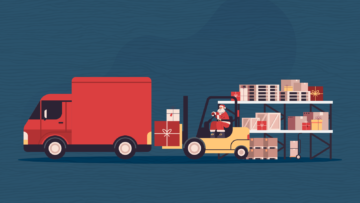5 Ways Food & Beverage Can Leverage Artificial Intelligence

AI, the theory and development of computer systems that can perform tasks that normally require human intelligence (e.g., visual perception, speech recognition, decision-making, and language translation), can become a compelling proposition for food and beverage companies that want to be “competitive-proof” in today’s rapidly-evolving business environment. AI has great promise in helping these companies improve their supply chain and operations processes.
Here’s how:
1. Enhance food quality and safety.
The global food chain and the farm-to-table sector have received some unwanted publicity recently due to a few high-profile cases of foodborne illnesses. This is an area where AI can really shine in the food supply chain, and it is, in fact, one of the first areas where we’re going to see high AI adoption rates within the food and beverage distribution industry. “Even in the 21st century, planting, harvesting, processing, packaging, and distribution require an enormous amount of manual labor,” Kate Brown points out in Risk & Insurance. “However, improvements in sensor technology, robotics, and artificial intelligence have the potential to significantly improve food safety. Experts say it’s no longer a matter of ‘if’ but ‘when.’ Throughout the chain of food production and distribution, automation is coming.“
2. Drive costs out of the supply chain.
Only when food and beverage companies improve quality, safety and serviceability can they effectively increase efficiency. This, in turn, ultimately reduces the operating costs of the overall supply chain and drives greater profitability for the company itself. Take food processing equipment, which requires regular repairs and upkeep. What if AI could tell you exactly when to do those repairs? Using a platform that combines automated data collection, IoT (to collect information from the equipment sensors), and company maintenance records, food and beverage companies can improve equipment uptime and minimize material loss to reduce the costs to produce within their supply chains. Compound that across multiple departments, locations, and divisions, and the cost savings begin to multiply even further.
3. Improve lot tracking and traceability.
Product spoilage, foodborne illnesses, and other food-related issues, all of which must adhere to myriad government regulations surrounding the manufacturing and distribution of food, are always top of mind for food and beverage distributors. Put simply, companies must know the complete path and whereabouts of its products—and then act in any potential recall situation related to that product—immediately. Using AI, sensors, and data, food and beverage companies can conduct expedient tracking and tracing and then use that information to identify, and proactively respond accordingly. Shipments of perishable products that must be stored at a certain temperature, for example, can be equipped with AI-enabled sensors that send out alerts before entire shipments spoil (or before they make their way into the consumer food chain). Any anomalies can be easily tracked back to the source and the problems remedied as quickly as possible.
4. Identify potentially “out of control” situations.
A big reason companies are adopting AI today is to be able to predict whenever a process or product is most likely to trend “out of control,” or outside of predefined tolerance/compliance levels. Using AI, companies can capture information about their processes and use advanced technology to monitor those processes, situations, and the supply chain in real-time. That means that a food manufacturer doesn’t have to wait until a consumer gets sick and reports it; it can identify the issue when a tractor trailer that’s driving down the Interstate might exceed the allowable operating temperature. This is just one of many ways AI can serve as a predictive warning sign that allows companies to get in front of problems—and solve them—before they turn into serious situations.
5. Integrate with other technology.
For AI to be most effective, it must be used in conjunction with other state-of-the-art technology, including IoT, ML, and information-rich databases. A dairy producer, for instance, operates under certain conditions that keep its products fresh and edible. Using IoT, the company monitors the equipment that’s processing the milk. If something goes awry in the operating conditions, the right people are alerted immediately. Even though the incident may produce some waste, being able to take corrective action immediately will translate into significantly less waste (as opposed to waiting until 500 gallons of the spoiled product has been produced to stop production).
Knowing at the point of occurrence or predicting a possible event and being able to take proactive steps to mitigate the risk, helps companies enhance service levels, product quality, and food safety—all of which ensure high levels of compliance and customer satisfaction.
Correlating “process control” to “product compliance” also enables continuous operational improvement beyond securing the top priority of consumer safety. Even if a safety issue never occurs, this correlation analysis provides valuable insight for the organization. Such knowledge is powerful for research & development, procurement, engineering, and production teams working together to improve the operation.
Bottom Line
Food and beverage companies recognize that the benefits of AI are abundant, but it’s not knowing where to get started that’s preventing many manufacturers from fully leveraging this technology.
First, don’t be afraid to seek the appropriate help. The inertia can be paralyzing. Bringing in a fresh set of eyes to provide coaching, insights and challenge your initial assumptions and predictions can help collapse time to start and help you realize the value of AI sooner. Postpone perfection and avoid analysis paralysis. Instead of focusing on the 10% of things you can’t get right, focus on the 90% where you can provide meaningful data today.
Next, start small with a prototype or pilot proof of concept. For example, start in packaging where you have information like how many goods are produced, scrapped, or re-worked. This area is relatively straightforward and easy to visualize. Take the data that you have today and use it to make decisions and take action. This generates excitement and momentum to expand into the next area.
And finally, take an inventory of what type of investments your company has already made where data is more readily available through IoT or some other automation system today. Harness that investment and build additional capabilities to make this data even more meaningful. All it may take is an extra sensor or piece of data to propel that investment to the next level.
For more tips on where to begin with AI, check out this article.



